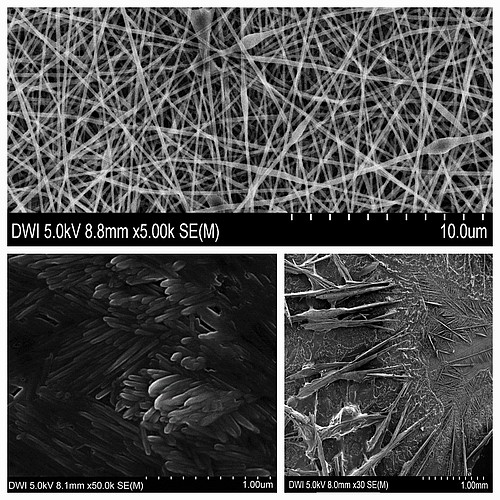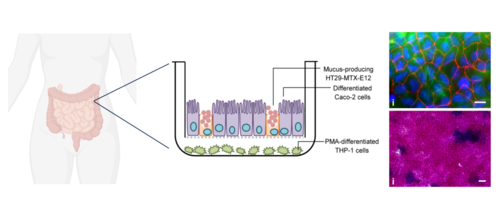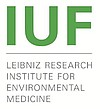Fallstudie A2
Fallstudie A2: Faser tox
High performance fibres made of ultra-high molar mass (UHMW) polymers progress into materials for filter, catalytic or sensory applications, if they are combined with metal oxide or metal nanoparticles. The fibres are used for creating systems with combined functions, e.g. for detection and concurrent photocatalytic removal of contaminants from water. Here, the fibres provide structural stability, including stability in harsh biologic environments, while the nanoparticles complement electric, sensory or catalytic properties.
Our aim is to understand how the combinaton of micro- and nano-sized building blocks affects human health and the environment. (see also Case study B2). Ingestion of high-performance fibres and fibre fragments via contaminated drinking water or food is well-recognised as a dominant exposure route. Inhalation exposure to airborne polymer fibres, fulfilling the WHO criteria for respirable fibres,9 and their degradation products is currently also gaining increasing attention.1,2 In our toxicological studies, we focus on digestive tract and respiratory tract. From the findings, we aim to provide guidelines and criteria for the development of sustainable materials of this class.
Example of high-molecular weight polymers
High performance fibres are often composted of (among others): Ramid (Kevlar®), Polyethylene (Spectra® and Dyneema®), Poly(p-Phenylene-2,6-Benzobisoxazole) (Zylon®).
Synthesis and functionalisation of the high performance fibres by DWI and IPF
DWI will exploit an established and reproducible method for preparing large quantities (0.5 – 1 g) of high performance fibres and fibre fragments made of synthetic polymers. IPF will provide metallic nanoparticles (Au, Ag) and metal oxide nanoparticles (TiO2) as typical examples for particles with sensing (plasmonic field enhancement) and photocatalytic functionality. The fibres will be combined with the nanoparticles at DWI in order to model application relevant advanced materials. As alternate approach, particle containing composite fibre materials prepared by electrospinning can be provided by INM. For understanding the impact of fibres and fibre fragments the materials are cut with a cryotome into sections of up to 1 µm in size. In order to better follow the fate of the fibres in biological systems, the model microfibres will be labelled with different fluorescence markers or metal traces. The stability of these fibres will be assessed in order to reveal their potential biopersistence – an important factor for hazard assessment.

Assessment of health hazards at IUF and IfADo
IUF will focus its research on in vitro models of the lung and intestines. Epithelial cells will be cocultured with macrophages to elucidate the toxicological effects of fibrous materials. The epithelium cells are producing mucus, thus allowing to examine the effects of mucus film on the fiber-cell-interactions. Realistic exposure conditions are applied for the lung models using air-liquid-interface (ALI) dosing, in which the fibres arrive at the lung cells / mucus via their air-facing side. For the intestinal model, artificial digestion fluid treatments mimic stomach passage effects on fibre-reactivity. In order to address established AOPs, selected cell samples will be analysed by deep sequencing technologies at IfADo towards hazard, ranking/grouping of the various types of fibres against fibrous benchmarks (mineral fibres, carbon nanotubes).


References and previous work
- Arts JHE et al., A decision-making framework for the grouping and testing of nanomaterials (DF4nanoGrouping) Regulatory Toxicol and Pharmacol 71 (2015) S1. https://doi.org/10.1016/j.yrtph.2015.03.00710
- Gasperi J et al., Microplastics in air: Are we breathing it in? Curr Opin Environ Sci Heal 1 (2018) 1. https://doi.org/10.1016/j.coesh.2017.10.002
Involved Partners





